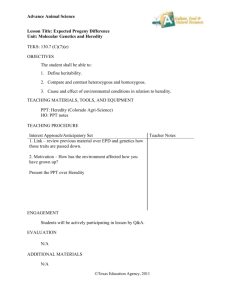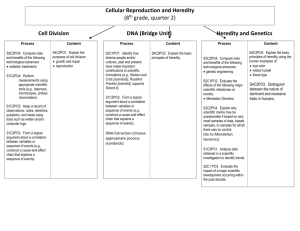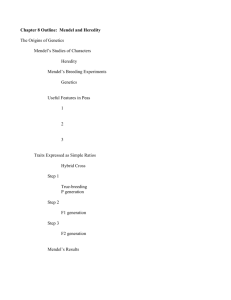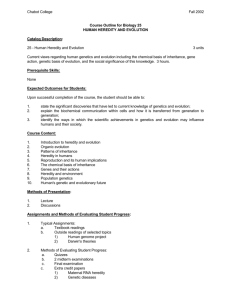Genetics: The Science of Variation
advertisement
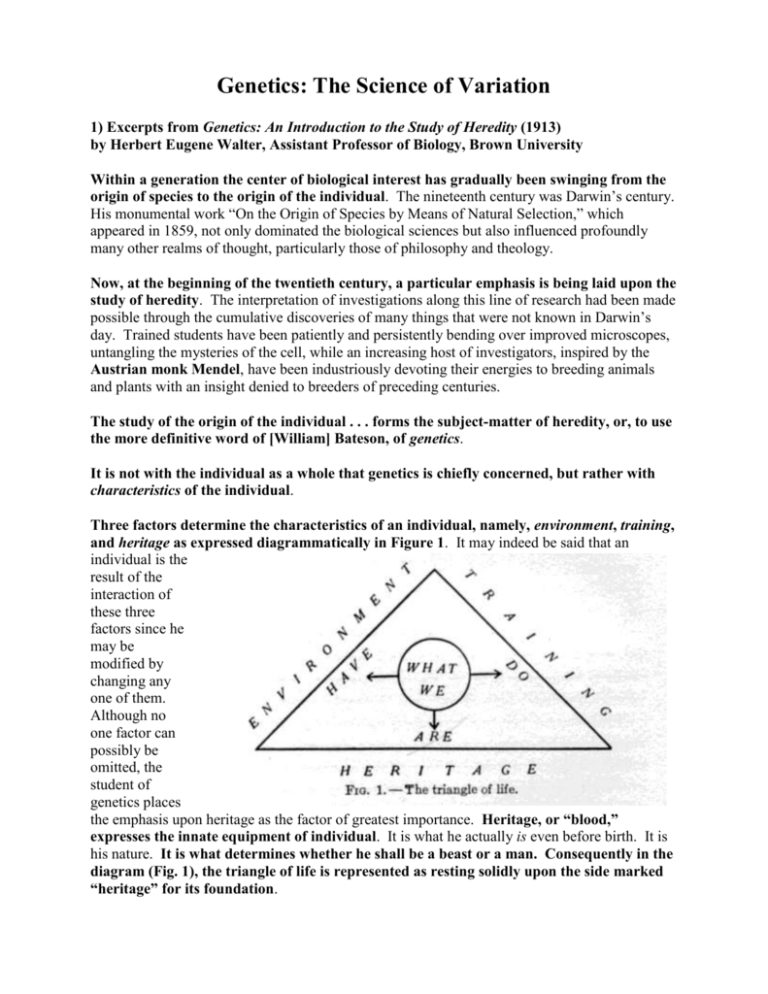
Genetics: The Science of Variation 1) Excerpts from Genetics: An Introduction to the Study of Heredity (1913) by Herbert Eugene Walter, Assistant Professor of Biology, Brown University Within a generation the center of biological interest has gradually been swinging from the origin of species to the origin of the individual. The nineteenth century was Darwin’s century. His monumental work “On the Origin of Species by Means of Natural Selection,” which appeared in 1859, not only dominated the biological sciences but also influenced profoundly many other realms of thought, particularly those of philosophy and theology. Now, at the beginning of the twentieth century, a particular emphasis is being laid upon the study of heredity. The interpretation of investigations along this line of research had been made possible through the cumulative discoveries of many things that were not known in Darwin’s day. Trained students have been patiently and persistently bending over improved microscopes, untangling the mysteries of the cell, while an increasing host of investigators, inspired by the Austrian monk Mendel, have been industriously devoting their energies to breeding animals and plants with an insight denied to breeders of preceding centuries. The study of the origin of the individual . . . forms the subject-matter of heredity, or, to use the more definitive word of [William] Bateson, of genetics. It is not with the individual as a whole that genetics is chiefly concerned, but rather with characteristics of the individual. Three factors determine the characteristics of an individual, namely, environment, training, and heritage as expressed diagrammatically in Figure 1. It may indeed be said that an individual is the result of the interaction of these three factors since he may be modified by changing any one of them. Although no one factor can possibly be omitted, the student of genetics places the emphasis upon heritage as the factor of greatest importance. Heritage, or “blood,” expresses the innate equipment of individual. It is what he actually is even before birth. It is his nature. It is what determines whether he shall be a beast or a man. Consequently in the diagram (Fig. 1), the triangle of life is represented as resting solidly upon the side marked “heritage” for its foundation. Environment and training, although indispensable, are both factors which are subsequent and secondary. Environment is what the individual has, for example, housing, food, friends and enemies, surrounding aids which may help him and obstacles which he must overcome. It is the particular world into which he comes . . . Training, or education, on the other hand, represents what the individual does with his heritage and environment. Lacking a suitable environment a good heritage may come to naught like good seed sown upon stony ground, but it is nevertheless true that the best environment cannot make up for defective heritage . . . Consequently the biologist holds that, although what an individual has and does is unquestionably of great importance, particularly to the individual himself, what he is, is far more important in the long run. Improved environment and education may better the generation already born. Improved blood will better every generation to come. [pp. 1-4] Diagram showing dominant and recessive characters in a variety of organisms 2) Excerpts from “The Factors of Organic Evolution,” from The Nature of the World and of Man (1927) by Horatio Hackett Newman, University of Chicago While the main highways of evolution are now well marked out, some of the bypaths are still obscure. All the facts so far presented may be organized and interpreted on an evolutionary assumption. Thousands of other facts have been satisfactorily explained on similar grounds, and there are at present no known facts contrary to the principle of evolution. For these reasons scientists the world over agree that the validity of the principle has been amply demonstrated. Many go so far as to rank evolution as a law of nature and assign to it a rank equal to that of the law of gravitation, the Copernican theory, the atomic theory, and the other great scientific generalizations. The basis of its validity is the same as theirs, for they all severally owe their high place in human regard to the fact that they explain and rationalize and unify the facts of nature . . . Let us then rest assured that the truth of evolution is demonstrated . . . While it may be generally agreed that certain causal factors co-operate to bring about evolution, few evolutionists would attach the same relative importance to the various factors. This is what is really meant when it is said that biologists are not at all in agreement about evolution. All are agreed as to the general fact and as to its main trends, but there is much disagreement of a technical sort as to the relative values of the co-operating causal factors . . . This is an age of rapid discovery in the field of evolution; most of our knowledge regarding its mechanism has come within the present century . . . A great biological problem.—The units of life as we know them are individuals, or organisms. Even within the limits of a species one encounters the utmost individual diversity. No two individuals are exactly alike; not even are two leaves on a tree or two scales on a fish exactly alike. Hence every individual is unique. Our first problem is that of determining just why each individual is just as it is. Broadly speaking, the peculiarities of an individual result from the co-operation of two factors, an intrinsic factor, heredity, and an extrinsic factor, environment. Some writers would include training as a third factor. Logically, however, there is no middle ground between intrinsic and extrinsic. Therefore, it seems best to consider training as one aspect of the environment. Heredity and environment.—The heredity of an organism includes everything that is passed along from one generation to another through the protoplasmic organization of the germ cells, both paternal and maternal. Typically, a new individual starts out in life as a single cell (zygote) produced by the union of two parent germ cells (gametes) known respectively as the egg and the sperm. The zygote is capable of developing only under certain definite environmental conditions. The environment not only conditions development but also determines to some extent the course and the character of development. Every peculiarity of an organism is the product of a long series of interactions not only between the organism and the environment but among different parts of the organism. A change in the environment may make a fish zygote develop into a somewhat different fish, but it cannot produce a new species of fish. Nor can similarity of environment cause the zygotes of two different species of fish to become alike. Environment than can modify development only within certain limits . . . FACTS AND THEORIES OF HEREDITY For a long time mankind has been aware of the general facts about heredity. This is attested by the numerous aphorisms, such as "Blood will tell"; "He is a chip off the old block"; "He comes from good (or bad) stock." . . . The first attempt to systematize the available data about heredity was that of Charles Darwin. In his famous book, Variation of Animals and Plants under Domestication, he presented a large amount of data about heredity, but this attempt to interpret the facts was largely a failure, for two reasons. First, there was no definite understanding about germ cells and the processes of sexual reproduction; second, in all hybridization experiments the individual as a whole was considered as the unit of heredity . . . How are the characters of the individual represented in the germ plasm? This is perhaps the leading problem of genetics. [August] Weismann thought that there was a specific determiner in the germ plasm for every character of the organism and that in the course of development the various determiners were segregated into different groups of body cells in such a way that each kind of cell got its own specific determiner. The germ cells, however, remain unchanged from generation to generation, each containing all the determiners characteristic of the species. This theory . . . has been profoundly modified by subsequent discoveries. The work of Gregor Mendel actually preceded that of Weismann by a good many years, but it was not appreciated until after the germ-plasm theory became current. Mendel . . . performed an extensive series of hybridization experiments with a number of varieties of cultivated peas. His analysis of results, a model of scientific method, was presented before an obscure local scientific society in 1865. Unfortunately it was virtually lost to the world for thirty-five years but was rediscovered in 1900. The rediscovery of Mendel's paper, Researches on PlantHybrids, was a great event, for it marked the beginning of scientific genetics. The early hybridizers before Mendel thought of the individual as the unit of heredity and considered that hybrid offspring were merely intermediate in type, that there was a sort of an averaging up of hereditary differences. Mendel came to the conclusion that the individual is not the unit of heredity, but that each individual is a complex of many independently heritable characters that may be separated from one another and recombined in the various offspring in a great variety of different ways. There is a regularity and definiteness about the separation and recombination of character differences that has come to be expressed in the form of certain rules or laws that are now called Mendel's laws. MENDEL'S LAWS The law of dominance.—Almost all of the unit characters show two or more different forms of expressions. Thus there are brown eyes, blue eyes, and hazel eyes; straight, kinky, and wavy hair; tall, short, and medium stature; broad and narrow nose. As a rule, two different expressions or forms of the same character are mutually exclusive, any single individual showing one or the other. When two individuals, differing with reference to a single unit character, mate, their offspring will show one or the other character expression. Thus a pure black guinea-pig when mated with a pure white or albino individual will have none but black offspring. That character difference which appears in the offspring to the exclusion of the other is known as dominant; the one that fails to appear, as recessive . . . The law of segregation.—This law is . . . undoubtedly the most significant and far-reaching of all the laws of heredity. We may illustrate the workings of this law by a continuation of the experiment involving the mating of black and white guinea-pigs. The first generation black hybrids (now universally known by the shorthand expression, F1) are interbred and, strangely enough, some of the offspring of the next generation (F2) are black and some white, in a very definite ratio of three blacks to one white. Thus the hybrids have split up in their offspring into the two forms that were originally bred together . . . It is a universal law that in the F2 generation there will appear on the average three dominants to one recessive . . . To black and white fur in guinea-pigs we may add smooth and rough coat. "Rough" is dominant over "smooth." Mate a black, smooth-haired guinea-pig with a white, rough-haired one [Figure 119]. The F1 generation will be all "black rough," for F1 individuals show only the dominant characters. Interbreed the F1 hybrids and we get the following F2 ratio: nine black rough to three black smooth to three white rough to one white smooth. In order to explain this ratio we need merely assume that black and white lie in one pair of chromosomes, rough and smooth lie in a different pair. Also we must assume that each pair behaves as if it were alone and uninfluenced by the other pair. The "black smooth" parent will give only black smooth gametes (Bs), the "white rough" parent will give only white rough gametes (wR) . . . If these unite with each other on a pure chance basis we may represent the result by the checkerboard method [See diagram below]. Wherever both B and R are present the individual will be "black rough" whether or not the recessive characters are also present. It is a simple matter to count nine out of sixteen are black rough, three that are black smooth, three that are white rough, and only one that contains no dominant genes and is therefore white smooth . . . THE ORIGIN OF NEW HEREDITARY CHARACTERS Differences in developed characters have been shown to be due to differences in the chemical packets or genes and to differences in the environment. Only by breeding successive generations under a constant environment is it possible to note changes in the genes. In the fruit fly, Drosophila melanogaster, [Thomas Hunt] Morgan and his collaborators have observed about four hundred gene changes in the last two decades. These so-called gene mutations affect changes in practically all parts of the body, the most obvious being those concerned with the color, shape, size, and texture of the eyes; size, shape, and texture of the wings; number, shape, and distribution of the bristles; changes in legs, body regions, internal organs; and numerous physiological characteristics such as general health or viability. Many changes are so serious in character as to shorten life or prevent the completion of development. Similar mutations of the gene type have been observed in many other animals and in not a few plants. In general, it may be said that any hereditary change that follows the laws of Mendelian heredity is due to a gene mutation . . . [pp. 381-400]

